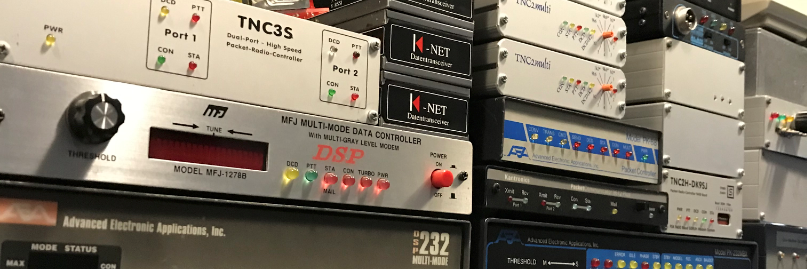I have a bad time behind me, I have had a lot of arguments with Systemd to start DireWolf and Linpq when booting 🙂
If you like Systemd, you can read some about it here https://en.wikipedia.org/wiki/Systemd
I want Linbpq to run under /dev/tty2 and DireWolf under /dev/tty3. This is because if I login remotely I can view the monitor from DireWolf with “conspy”. “conspy 3” Hit esc a few times to leave conspy.
Systemd does not want to accept the start line with >/dev/tty3 &
ExecStart=/usr/local/bin/direwolf -c /home/pd9q/direwolf.conf -l /home/pd9q/direwolf.log >/dev/tty3
This upper start line does not work.
So I had to come up with something else for that. So i wrote a start file. “direwolf.start”
cd /usr/local/bin ./direwolf -c /home/pd9q/direwolf.conf -l /home/pd9q/direwolf.log >/dev/tty3
Now i wrote a unit file to start DireWolf on boot.
/etc/systemd/system/direwolf.service
[Unit] Description=DireWolf Deamon After=network.target After=sound.target After=syslog.target [Service] Type=simple ExecStart=/bin/bash /home/pd9q/linbpq/direwolf.start [Install] WantedBy=multi-user.target Alias=direwolf.service
Now DireWolf is starting very nice on /dev/tty3
pd9q@packet:~ $ systemctl status direwolf.service
● direwolf.service - DireWolf Deamon
Loaded: loaded (/lib/systemd/system/direwolf.service; enabled; vendor preset: enabled)
Active: active (running) since Wed 2018-09-12 10:58:51 UTC; 1h 18min ago
Main PID: 463 (bash)
CGroup: /system.slice/direwolf.service
├─463 /bin/bash /home/pd9q/linbpq/direwolf.start
└─474 ./direwolf -c /home/pd9q/direwolf.conf -l /home/pd9q/direwolf.log
Sep 12 10:58:51 packet systemd[1]: Started DireWolf Deamon.
pd9q@packet:~ $
I had the same problem with Linbpq, which I solved in the same way.
Linbpq start file “runbpq”
cd /home/pd9q/linbpq sudo ./linbpq >/dev/tty2
The unit file “linbpq.service”
[Unit] Description=Linbpq Daemon After=network.target After=direwolf.target StartLimitInterval=0 [Service] Type=simple Restart=always RestartSec=5 ExecStart=/bin/bash /home/pd9q/linbpq/runbpq WorkingDirectory=/home/pd9q/linbpq [Install] WantedBy=multi-user.target Alias=linbpq.service
Ok, let’s see if it is running
pd9q@packet:~ $ systemctl status linbpq.service
● linbpq.service - Linbpq Daemon
Loaded: loaded (/lib/systemd/system/linbpq.service; enabled; vendor preset: enabled)
Active: active (running) since Wed 2018-09-12 10:58:51 UTC; 1h 23min ago
Main PID: 464 (bash)
CGroup: /system.slice/linbpq.service
├─464 /bin/bash /home/pd9q/linbpq/runbpq
├─473 sudo ./linbpq
└─501 ./linbpq
Sep 12 12:13:36 packet LINBPQ[501]: BPQ32 Heartbeat Buffers 102
Sep 12 12:14:31 packet LINBPQ[501]: BPQ32 Heartbeat Buffers 99
Sep 12 12:15:27 packet LINBPQ[501]: BPQ32 Heartbeat Buffers 102
Sep 12 12:16:22 packet LINBPQ[501]: BPQ32 Heartbeat Buffers 102
Sep 12 12:17:17 packet LINBPQ[501]: BPQ32 Heartbeat Buffers 102
Sep 12 12:18:12 packet LINBPQ[501]: BPQ32 Heartbeat Buffers 100
Sep 12 12:19:07 packet LINBPQ[501]: BPQ32 Heartbeat Buffers 102
Sep 12 12:20:03 packet LINBPQ[501]: BPQ32 Heartbeat Buffers 102
Sep 12 12:20:58 packet LINBPQ[501]: BPQ32 Heartbeat Buffers 102
Sep 12 12:21:53 packet LINBPQ[501]: BPQ32 Heartbeat Buffers 102
pd9q@packet:~ $
Now have a look at /dev/tty2 “conspy 2”
G8BPQ AX25 Packet Switch System Version 6.0.16.30 July 2018 Copyright ▒ 2001-2018 John Wiseman G8BPQ Current Directory is /home/pd9q/linbpq Configuration file Preprocessor. Using Configuration file /home/pd9q/linbpq/bpq32.cfg Conversion (probably) successful PORTS 1d9784 LINKS 1dce14 DESTS 1dfc58 ROUTES 1f9c58 L4 1fd058 BUFFERS 22f170 Initialising Port 01 TCPKISS IP 127.0.0.1 Port 8001 Chan A Initialising Port 02 AXIP Initialising Port 03 Telnet Server Initialising Port 04 Loopback

